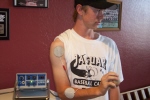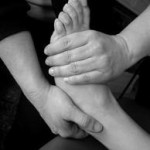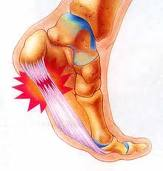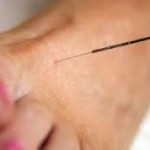Physiotherapy and Physical Medicine Services:
ARP WAVE / Therastim
Accelerated Recovery Performance Trainer.
Everyday people who have aches and pains to weekend warriors to professional athletes in the NFL, NHL, MLB, PGA, as well as Olympians, use the TheraStim to treat injuries and help them recover more rapidly. It also aids muscles in the recovery of extensive training and over-exertion. It has also been used to speed up post-surgical recovery.
Active Release
Developed by P. Michael Leahy, DC.
ART is a manual soft tissue technique using the examiners hands to apply the technique. The main concept is to reestablish motion between fascial planes thus reducing fibrous adhesions and reestablishing neural and myofascial glide between tissues. The technique utilizes patient active motion when ever possible. A tension contact is used as opposed to compressive contacts used in other soft tissue techniques. The primary  direction is to go with venous drainage during an ART treatment although reverse directions are occasionally used with appropriate modification. I currently use ART on 100% of my patients. My practice is specifically referral from patients, medical practitioners, physical therapists and chiropractors. The technique is applied to acute, chronic, overuse; repetitive strain injuries and NMS post operative cases of all types. The number of postoperative cases is growing constantly. The technique is dynamic, it only requires you to use your hands and contrary to popular belief a lubricant is not necessary when the technique is applied correctly.
direction is to go with venous drainage during an ART treatment although reverse directions are occasionally used with appropriate modification. I currently use ART on 100% of my patients. My practice is specifically referral from patients, medical practitioners, physical therapists and chiropractors. The technique is applied to acute, chronic, overuse; repetitive strain injuries and NMS post operative cases of all types. The number of postoperative cases is growing constantly. The technique is dynamic, it only requires you to use your hands and contrary to popular belief a lubricant is not necessary when the technique is applied correctly.
Joint Manipulation And Taping 
Physiotherapists are trained to perform movements on you, where the therapist moves the limb/joint whilst you keep your muscles relaxed.
mobilization and manipulation techniques are commonly used when you have pain and stiffness around a joint or muscle. Rest assured that the therapist is within the control of yourself so that the movement can be stopped if you so wish.
Mobilization is where the therapist uses smooth movements of 2 or 3 seconds of small or large force anywhere within the range of movement of the joint.
Manipulation is the next step from mobilisation, where the therapist applies a thrust of small force on the joint at the end of its range of movement.
The Graston Technique (GISTM)
 Developed by David Graston who suffered a multiple ligament injury of his knee in an accident in 1987. The surgical reconstruction left him with limited range of motion. Having failed traditional physical therapy or orthopedic management he began using cross friction massage as described by Cyriax. The extensive manual work caused fatigue in his hands and he subsequently developed stainless steal tools to assist in the application of myofascial work on scar tissue. The Graston Instrument assisted soft tissue mobilization technique is a soft tissue technique designed to mobilize, reduce and reorganize fibrotic restrictions in the neuromusculoskeletal system. The technique is delivered through the use of six (6) hand held stainless steel instruments. A specially designed lubricant must be applied to the skin prior to utilizing the instrument. The lubricant allows the instrument to glide over the skin without causing irritation. The special lubricant also allows the instrument to glide without causing an accumulation of the lubricant on the instrument as commonly happens with ultrasound gel on an ultrasound head.
Developed by David Graston who suffered a multiple ligament injury of his knee in an accident in 1987. The surgical reconstruction left him with limited range of motion. Having failed traditional physical therapy or orthopedic management he began using cross friction massage as described by Cyriax. The extensive manual work caused fatigue in his hands and he subsequently developed stainless steal tools to assist in the application of myofascial work on scar tissue. The Graston Instrument assisted soft tissue mobilization technique is a soft tissue technique designed to mobilize, reduce and reorganize fibrotic restrictions in the neuromusculoskeletal system. The technique is delivered through the use of six (6) hand held stainless steel instruments. A specially designed lubricant must be applied to the skin prior to utilizing the instrument. The lubricant allows the instrument to glide over the skin without causing irritation. The special lubricant also allows the instrument to glide without causing an accumulation of the lubricant on the instrument as commonly happens with ultrasound gel on an ultrasound head.
The treatment is applied in multiple directions: with venous drainage, against venous drainage and cross fiber in multiple directions to the lesion. As with other soft tissue techniques the treatment application is also part of the diagnostic process. As the Graston tools are applied a “vibratory” sensation is felt through the tool to the examiners fingertips. The patient simultaneously experiences a similar sensation while the tool traverses the area being treated.
Taping is a technique used by physios and sports professionals. Special tape is used, taping around muscles and joints for support. In cases after injury, you can use taping to restrict the movement of a joint to protect it from further injury.
 Acupuncture
Acupuncture
This is not strictly a part of the main physiotherapy treatments, but many physios have trained to practice it. It is basically known as “sticking needles into you”. Well I’m sure there are a few people you’d like to do that to!! But acupuncture is a very old Chinese therapy, based on energy flow within your body.
Your therapist will insert a very thin needle (so thin that it won’t break your skin i.e. no blood, so it’s nothing like getting an injection) into very specific parts of your body. The needle will free any block of energy flow in that part of your body, helping it get back to it’s normal state, e.g. pain free.
You will usually need a course of acupuncture treatment, although some people see results after the first treatment. Acupuncture is a great treatment to try, if your other physiotherapy treatments have not helped you much.
Even if you have a fear of needles, I would recommend you go with a friend or relative for support, and get that first treatment done. You’ll see how it doesn’t hurt and the needles are so thin, once they’re in, you hardly notice them at all!
Electrotherapy (including Ultrasound)
There are different types of electrotherapy, varying by using heat, sound waves or electrical stimulation. These are good for treating pain in muscles and joints, swelling, and to help the healing process. The different types of these physiotherapy treatments are:
Infrared..an infrared lamp is placed parallel to your joint, with your skin uncovered and examined prior to treatment. Heat from the infrared rays warms your specific muscles. You may feel a mild gentle warmth, anything hotter then this feeling should be reported.
Ultrasound..for parts of your body that are relatively flat, the gel is applied on to your skin, and the applicator is moved over the surface of your skin. For parts that have irregular surfaces, it is placed in a bath of warm water. The head of the applicator is placed in the bath and moved around next to the part to be treated. You should feel no sensation at all either way.
TENS.. Transcutaneous Electrical Nerve Stimulation (TENS) is normally used to treat pain. The electrodes are placed on your skin and the intensity gradually increased. Depending on the frequency, you should either feel a slow tickling sensation, or a continuous buzzing sensation. You will be able to feel which frequency is best for your pain. The intensity should never be strong or painful.